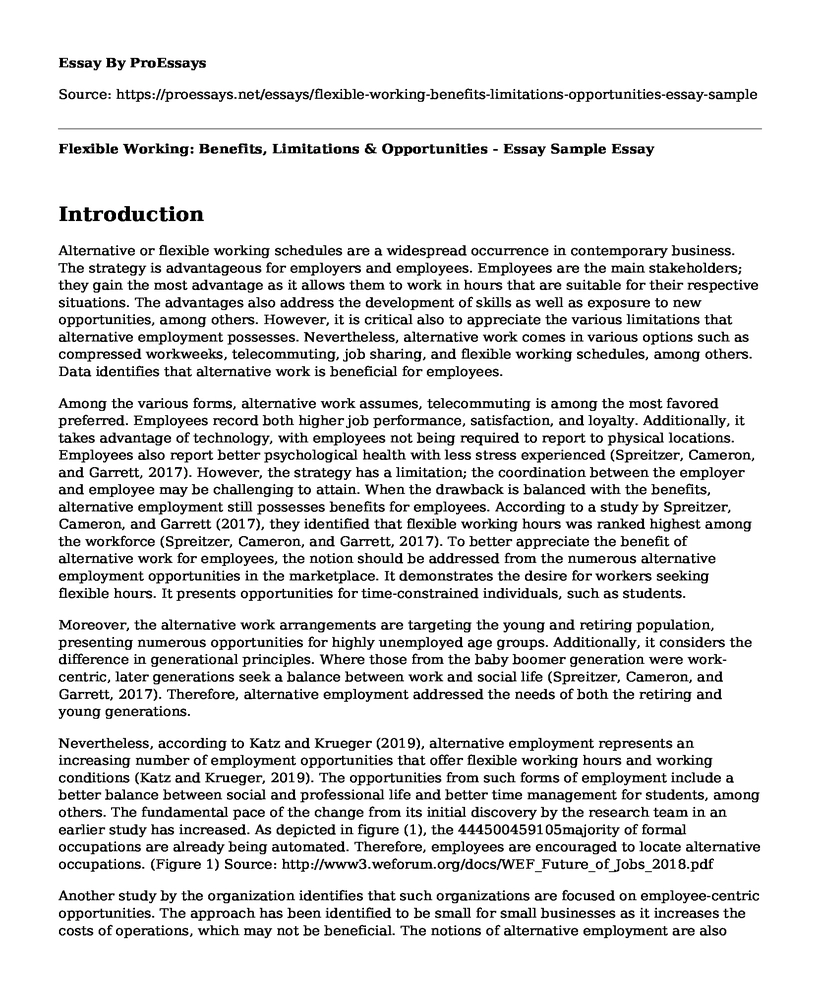Introduction
Alternative or flexible working schedules are a widespread occurrence in contemporary business. The strategy is advantageous for employers and employees. Employees are the main stakeholders; they gain the most advantage as it allows them to work in hours that are suitable for their respective situations. The advantages also address the development of skills as well as exposure to new opportunities, among others. However, it is critical also to appreciate the various limitations that alternative employment possesses. Nevertheless, alternative work comes in various options such as compressed workweeks, telecommuting, job sharing, and flexible working schedules, among others. Data identifies that alternative work is beneficial for employees.
Among the various forms, alternative work assumes, telecommuting is among the most favored preferred. Employees record both higher job performance, satisfaction, and loyalty. Additionally, it takes advantage of technology, with employees not being required to report to physical locations. Employees also report better psychological health with less stress experienced (Spreitzer, Cameron, and Garrett, 2017). However, the strategy has a limitation; the coordination between the employer and employee may be challenging to attain. When the drawback is balanced with the benefits, alternative employment still possesses benefits for employees. According to a study by Spreitzer, Cameron, and Garrett (2017), they identified that flexible working hours was ranked highest among the workforce (Spreitzer, Cameron, and Garrett, 2017). To better appreciate the benefit of alternative work for employees, the notion should be addressed from the numerous alternative employment opportunities in the marketplace. It demonstrates the desire for workers seeking flexible hours. It presents opportunities for time-constrained individuals, such as students.
Moreover, the alternative work arrangements are targeting the young and retiring population, presenting numerous opportunities for highly unemployed age groups. Additionally, it considers the difference in generational principles. Where those from the baby boomer generation were work-centric, later generations seek a balance between work and social life (Spreitzer, Cameron, and Garrett, 2017). Therefore, alternative employment addressed the needs of both the retiring and young generations.
Nevertheless, according to Katz and Krueger (2019), alternative employment represents an increasing number of employment opportunities that offer flexible working hours and working conditions (Katz and Krueger, 2019). The opportunities from such forms of employment include a better balance between social and professional life and better time management for students, among others. The fundamental pace of the change from its initial discovery by the research team in an earlier study has increased. As depicted in figure (1), the 444500459105majority of formal occupations are already being automated. Therefore, employees are encouraged to locate alternative occupations. (Figure 1) Source: http://www3.weforum.org/docs/WEF_Future_of_Jobs_2018.pdf
Another study by the organization identifies that such organizations are focused on employee-centric opportunities. The approach has been identified to be small for small businesses as it increases the costs of operations, which may not be beneficial. The notions of alternative employment are also supported by (Greszler, 2017). Her study on Uber identified that the platform does not conform to employment agreements. Furthermore, she addresses job flexibility as an "immeasurable" form of compensation.
Figure 2: Source: https://www.heritage.org/sites/default/files/2017-09/BG3246.pdf
As previously stated, the main limitation of alternative employment is the lack of time coordination with the employer. America, as a country, is significant, containing six time zones (Budd and Bhave, 2019). It may present problems when telecommuting with employers at different time zones. Additionally, employees may fail to distinguish between homework.
Conclusion
Data identifies that alternative employment is beneficial for employers and employees. In the case of employees, it presents both job flexibility and opportunities. Employees can learn new skills as well as interact with influential individuals who may promote their prospective careers. In other words, alternative employment offers both occupational as well as social benefits.
References
Budd, J. W., & Bhave, D. P. (2019). The employment relationship: Key elements, alternative frames of reference, and implications for HRM. SAGE handbook of human resource management, 41-64.
Greszler, R. (2017). The Value of Flexible Work Is Higher Than You May Think. Retrieved 7 April 2020, from http://report.heritage.org/bg3246
Katz, L. F., & Krueger, A. B. (2019). Understanding trends in alternative work arrangements in the United States. RSF: The Russell Sage Foundation Journal of the Social Sciences, 5(5), 132-146.
Spreitzer, G. M., Cameron, L., & Garrett, L. (2017). Alternative work arrangements: Two images of the new world of work. Annual Review of Organizational Psychology and Organizational Behavior, 4, 473-499.
Cite this page
Flexible Working: Benefits, Limitations & Opportunities - Essay Sample. (2023, May 12). Retrieved from https://proessays.net/essays/flexible-working-benefits-limitations-opportunities-essay-sample
If you are the original author of this essay and no longer wish to have it published on the ProEssays website, please click below to request its removal:
- Essay Example: Undocumented Babysitters in Bay Area
- Essay on Problem-Solving Skills for Fresh Graduates in Singapore
- Career in Criminal Justice System Essay Example
- Essay Example on the Media Industry: Be at the Right Place to Succeed
- Essay Sample on the Benefits of Community Public Health Officers
- Essay Example on Conflict Management in the Workplace: Strategies and Effectiveness
- Free Essay Sample on Business Entities, Contract Law & Vicarious Liability







